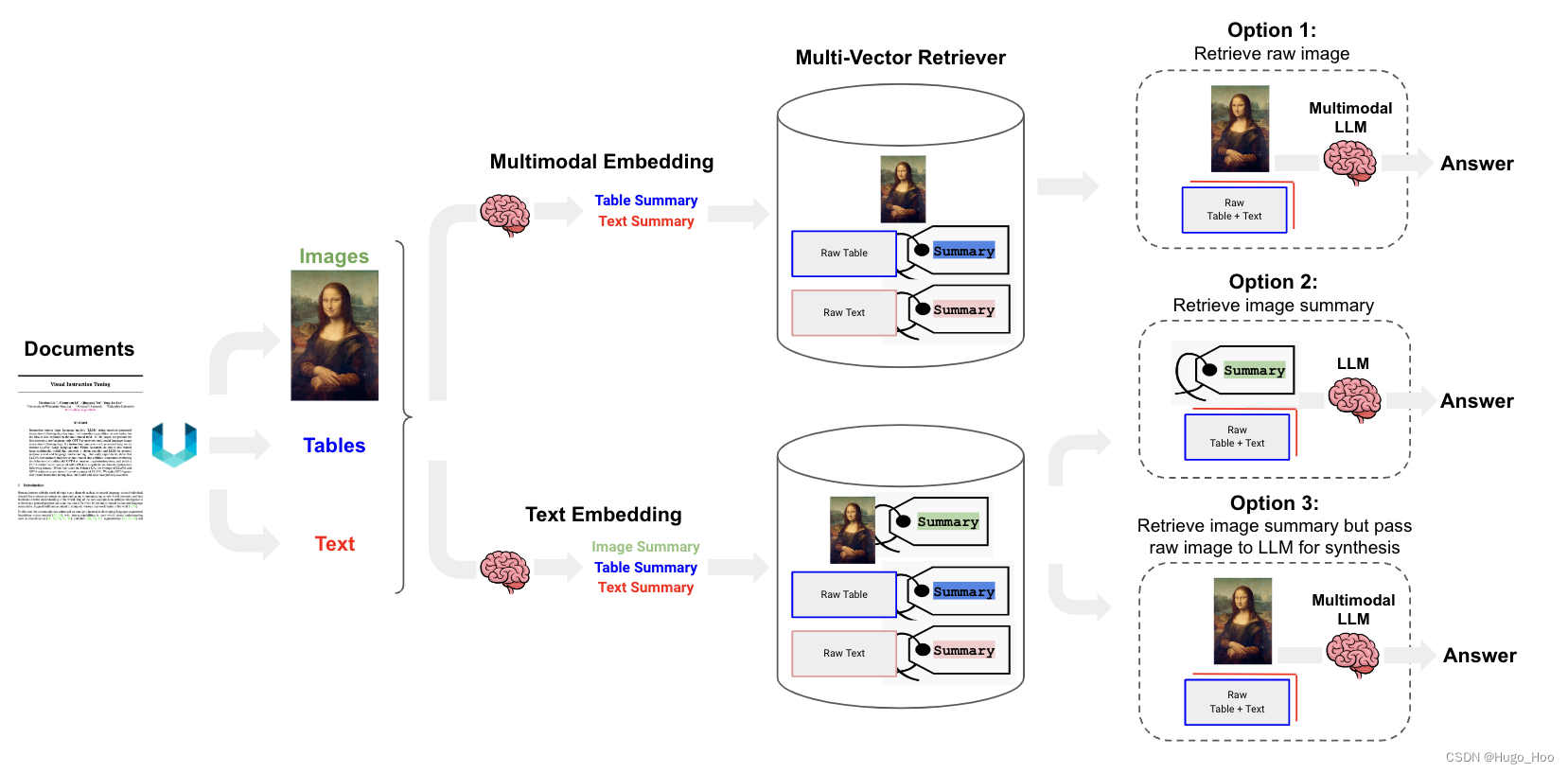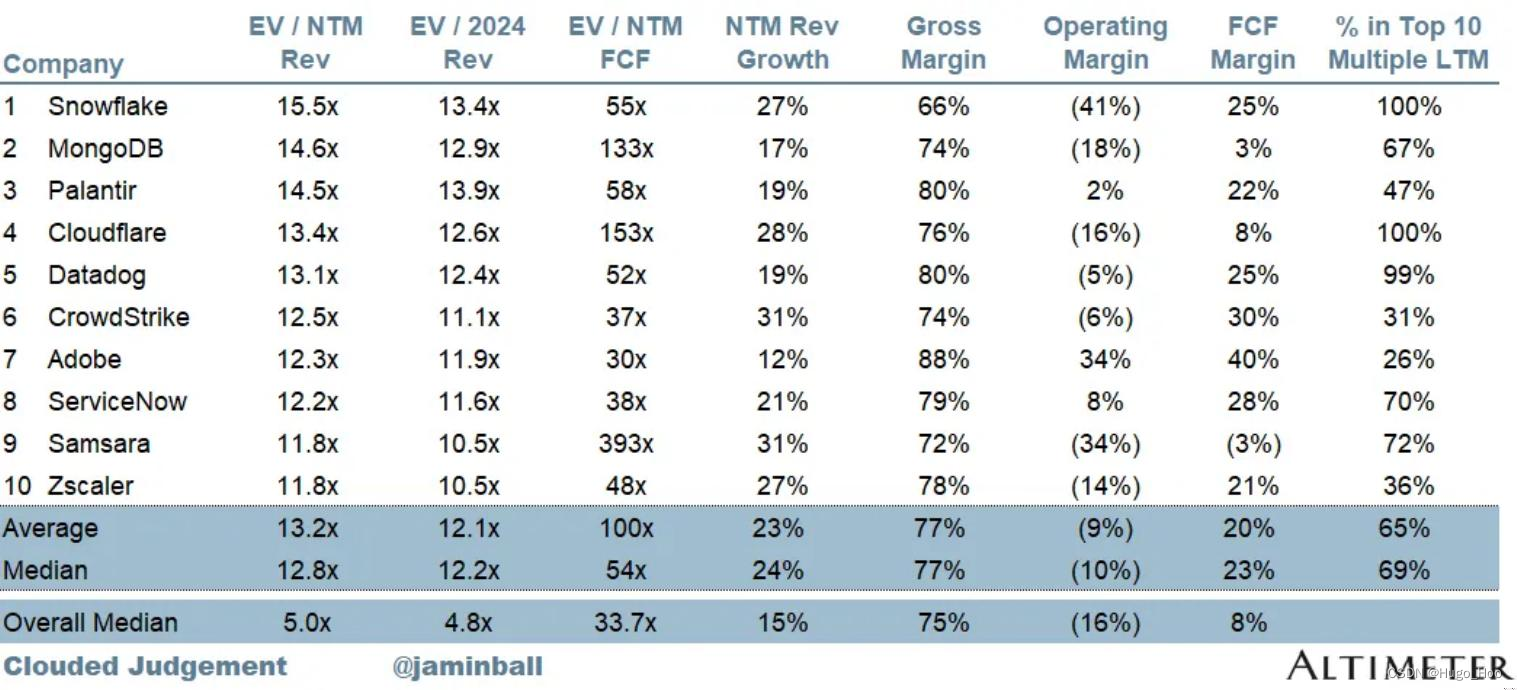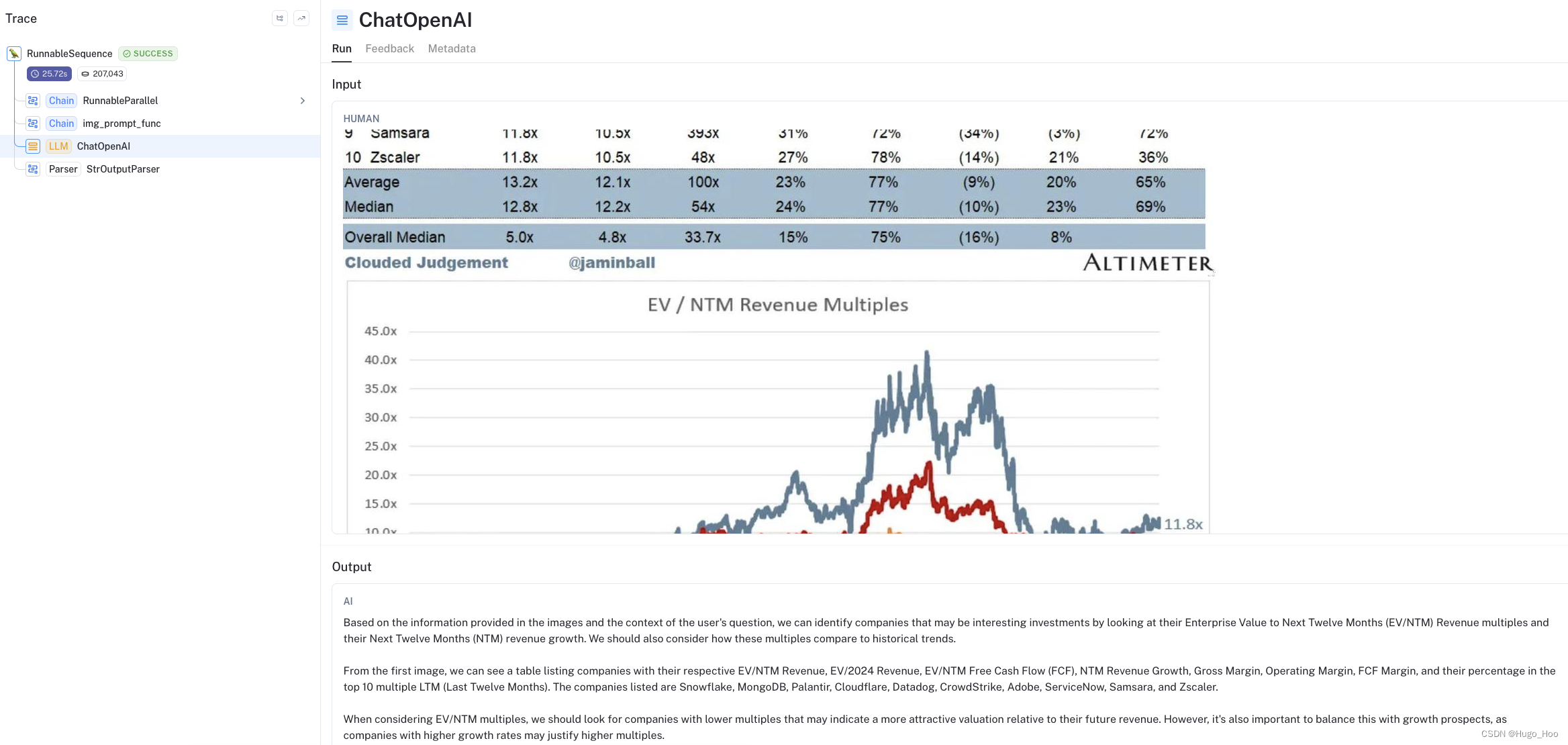多模态 RAG
许多文档包含多种内容类型,包括文本和图像。
然而,大多数 RAG 应用中,图像中捕获的信息往往被忽略。
随着多模态 LLM 的出现,如 GPT-4V,值得考虑如何在 RAG 中利用图像:
选项 1:
- 使用多模态嵌入(例如 CLIP)来嵌入图像和文本
- 使用相似性搜索检索图像和文本
- 将原始图像和文本片段传递给多模态 LLM 进行答案合成
选项 2:
- 使用多模态 LLM(例如 GPT-4V、LLaVA 或 FUYU-8b)从图像生成文本摘要
- 嵌入并检索文本
- 将文本片段传递给 LLM 进行答案合成
选项 3:
- 使用多模态 LLM(例如 GPT-4V、LLaVA、或 FUYU-8b)直接从图像和文本中生成答案
- 使用引用原始图像嵌入和检索图像摘要
- 将原始图像和文本块传递到多模态LLM以进行答案合成
本文重点介绍选项3 。
- 我们将使用非结构化来解析文档 (PDF) 中的图像、文本和表格。
- 我们将使用带有 Chroma 的多向量检索器来存储原始文本和图像以及它们的摘要以供检索。
- 我们将使用 GPT-4V 进行图像摘要(用于检索)以及通过图像和文本(或表格)的联合审查进行最终答案合成。
该选项 Option 2 适用于LLM无法使用多模态进行答案综合的情况(例如,成本等)。

Packages 包
除了以下pip包外,您还需要系统中的 poppler (安装说明)和 tesseract (安装说明)。
! pip install -U langchain openai chromadb langchain-experimental # (newest versions required for multi-modal)! pip install "unstructured[all-docs]" pillow pydantic lxml pillow matplotlib chromadb tiktoken
Data Loading 数据加载
对 PDF 表格、文本和图像进行分区
让我们看看 Jamin Ball 的一个受欢迎的博客。
这是一个很好的用例,因为大部分信息都是在图像(表格或图表)中捕获的。
我们用它来 Unstructured 对它进行分区。
要跳过 Unstructured 提取:
这是一个 zip 文件,其中包含提取的图像和 pdf 的子集。
如果您想使用提供的文件夹,那么只需为文档选择 pdf 加载器:
from langchain_community.document_loaders import PyPDFLoader
loader = PyPDFLoader(path + fname)
docs = loader.load()
tables = [] # Ignore w/ basic pdf loader
texts = [d.page_content for d in docs]
from langchain_text_splitters import CharacterTextSplitter
from unstructured.partition.pdf import partition_pdf# Extract elements from PDF
def extract_pdf_elements(path, fname):"""Extract images, tables, and chunk text from a PDF file.path: File path, which is used to dump images (.jpg)fname: File name"""return partition_pdf(filename=path + fname,extract_images_in_pdf=False,infer_table_structure=True,chunking_strategy="by_title",max_characters=4000,new_after_n_chars=3800,combine_text_under_n_chars=2000,image_output_dir_path=path,)# Categorize elements by type
def categorize_elements(raw_pdf_elements):"""Categorize extracted elements from a PDF into tables and texts.raw_pdf_elements: List of unstructured.documents.elements"""tables = []texts = []for element in raw_pdf_elements:if "unstructured.documents.elements.Table" in str(type(element)):tables.append(str(element))elif "unstructured.documents.elements.CompositeElement" in str(type(element)):texts.append(str(element))return texts, tables# File path
fpath = "/Users/rlm/Desktop/cj/"
fname = "cj.pdf"# Get elements
raw_pdf_elements = extract_pdf_elements(fpath, fname)# Get text, tables
texts, tables = categorize_elements(raw_pdf_elements)# Optional: Enforce a specific token size for texts
text_splitter = CharacterTextSplitter.from_tiktoken_encoder(chunk_size=4000, chunk_overlap=0
)
joined_texts = " ".join(texts)
texts_4k_token = text_splitter.split_text(joined_texts)
Multi-vector retriever 多向量检索器
使用多向量检索器对图像(和/或文本、表格)摘要进行索引,但检索原始图像(以及原始文本或表格)。
Text and Table summaries 文本和表格摘要
我们将使用 GPT-4 来生成表格和可选的文本摘要。
如果使用较大的块大小(例如,如上所述,我们使用 4k 令牌块),则建议使用文本摘要。
摘要用于检索原始表和/或原始文本块。
from langchain_core.output_parsers import StrOutputParser
from langchain_core.prompts import ChatPromptTemplate
from langchain_openai import ChatOpenAI# Generate summaries of text elements
def generate_text_summaries(texts, tables, summarize_texts=False):"""Summarize text elementstexts: List of strtables: List of strsummarize_texts: Bool to summarize texts"""# Promptprompt_text = """You are an assistant tasked with summarizing tables and text for retrieval. \These summaries will be embedded and used to retrieve the raw text or table elements. \Give a concise summary of the table or text that is well optimized for retrieval. Table or text: {element} """prompt = ChatPromptTemplate.from_template(prompt_text)# Text summary chainmodel = ChatOpenAI(temperature=0, model="gpt-4")summarize_chain = {"element": lambda x: x} | prompt | model | StrOutputParser()# Initialize empty summariestext_summaries = []table_summaries = []# Apply to text if texts are provided and summarization is requestedif texts and summarize_texts:text_summaries = summarize_chain.batch(texts, {"max_concurrency": 5})elif texts:text_summaries = texts# Apply to tables if tables are providedif tables:table_summaries = summarize_chain.batch(tables, {"max_concurrency": 5})return text_summaries, table_summaries# Get text, table summaries
text_summaries, table_summaries = generate_text_summaries(texts_4k_token, tables, summarize_texts=True
)
Image summaries 图像摘要
我们将使用 GPT-4V 来生成图像摘要。
此处的 API 文档:
- 我们传递 base64 编码的图像
import base64
import osfrom langchain_core.messages import HumanMessagedef encode_image(image_path):"""Getting the base64 string"""with open(image_path, "rb") as image_file:return base64.b64encode(image_file.read()).decode("utf-8")def image_summarize(img_base64, prompt):"""Make image summary"""chat = ChatOpenAI(model="gpt-4-vision-preview", max_tokens=1024)msg = chat.invoke([HumanMessage(content=[{"type": "text", "text": prompt},{"type": "image_url","image_url": {"url": f"data:image/jpeg;base64,{img_base64}"},},])])return msg.contentdef generate_img_summaries(path):"""Generate summaries and base64 encoded strings for imagespath: Path to list of .jpg files extracted by Unstructured"""# Store base64 encoded imagesimg_base64_list = []# Store image summariesimage_summaries = []# Promptprompt = """You are an assistant tasked with summarizing images for retrieval. \These summaries will be embedded and used to retrieve the raw image. \Give a concise summary of the image that is well optimized for retrieval."""# Apply to imagesfor img_file in sorted(os.listdir(path)):if img_file.endswith(".jpg"):img_path = os.path.join(path, img_file)base64_image = encode_image(img_path)img_base64_list.append(base64_image)image_summaries.append(image_summarize(base64_image, prompt))return img_base64_list, image_summaries# Image summaries
img_base64_list, image_summaries = generate_img_summaries(fpath)
Add to vectorstore 添加到矢量存储
将原始文档和文档摘要添加到 Multi Vector Retriever:
- 将原始文本、表格和图像存储在 docstore .
- 将文本、表格摘要和图像摘要存储在 中 vectorstore,以便进行有效的语义检索。
import uuidfrom langchain.retrievers.multi_vector import MultiVectorRetriever
from langchain.storage import InMemoryStore
from langchain_community.vectorstores import Chroma
from langchain_core.documents import Document
from langchain_openai import OpenAIEmbeddingsdef create_multi_vector_retriever(vectorstore, text_summaries, texts, table_summaries, tables, image_summaries, images
):"""Create retriever that indexes summaries, but returns raw images or texts"""# Initialize the storage layerstore = InMemoryStore()id_key = "doc_id"# Create the multi-vector retrieverretriever = MultiVectorRetriever(vectorstore=vectorstore,docstore=store,id_key=id_key,)# Helper function to add documents to the vectorstore and docstoredef add_documents(retriever, doc_summaries, doc_contents):doc_ids = [str(uuid.uuid4()) for _ in doc_contents]summary_docs = [Document(page_content=s, metadata={id_key: doc_ids[i]})for i, s in enumerate(doc_summaries)]retriever.vectorstore.add_documents(summary_docs)retriever.docstore.mset(list(zip(doc_ids, doc_contents)))# Add texts, tables, and images# Check that text_summaries is not empty before addingif text_summaries:add_documents(retriever, text_summaries, texts)# Check that table_summaries is not empty before addingif table_summaries:add_documents(retriever, table_summaries, tables)# Check that image_summaries is not empty before addingif image_summaries:add_documents(retriever, image_summaries, images)return retriever# The vectorstore to use to index the summaries
vectorstore = Chroma(collection_name="mm_rag_cj_blog", embedding_function=OpenAIEmbeddings()
)# Create retriever
retriever_multi_vector_img = create_multi_vector_retriever(vectorstore,text_summaries,texts,table_summaries,tables,image_summaries,img_base64_list,
)
RAG
构建检索器
我们需要将检索到的文档装箱到 GPT-4V 提示模板的正确部分。
import io
import refrom IPython.display import HTML, display
from langchain_core.runnables import RunnableLambda, RunnablePassthrough
from PIL import Imagedef plt_img_base64(img_base64):"""Disply base64 encoded string as image"""# Create an HTML img tag with the base64 string as the sourceimage_html = f'<img src="data:image/jpeg;base64,{img_base64}" />'# Display the image by rendering the HTMLdisplay(HTML(image_html))def looks_like_base64(sb):"""Check if the string looks like base64"""return re.match("^[A-Za-z0-9+/]+[=]{0,2}$", sb) is not Nonedef is_image_data(b64data):"""Check if the base64 data is an image by looking at the start of the data"""image_signatures = {b"\xff\xd8\xff": "jpg",b"\x89\x50\x4e\x47\x0d\x0a\x1a\x0a": "png",b"\x47\x49\x46\x38": "gif",b"\x52\x49\x46\x46": "webp",}try:header = base64.b64decode(b64data)[:8] # Decode and get the first 8 bytesfor sig, format in image_signatures.items():if header.startswith(sig):return Truereturn Falseexcept Exception:return Falsedef resize_base64_image(base64_string, size=(128, 128)):"""Resize an image encoded as a Base64 string"""# Decode the Base64 stringimg_data = base64.b64decode(base64_string)img = Image.open(io.BytesIO(img_data))# Resize the imageresized_img = img.resize(size, Image.LANCZOS)# Save the resized image to a bytes bufferbuffered = io.BytesIO()resized_img.save(buffered, format=img.format)# Encode the resized image to Base64return base64.b64encode(buffered.getvalue()).decode("utf-8")def split_image_text_types(docs):"""Split base64-encoded images and texts"""b64_images = []texts = []for doc in docs:# Check if the document is of type Document and extract page_content if soif isinstance(doc, Document):doc = doc.page_contentif looks_like_base64(doc) and is_image_data(doc):doc = resize_base64_image(doc, size=(1300, 600))b64_images.append(doc)else:texts.append(doc)return {"images": b64_images, "texts": texts}def img_prompt_func(data_dict):"""Join the context into a single string"""formatted_texts = "\n".join(data_dict["context"]["texts"])messages = []# Adding image(s) to the messages if presentif data_dict["context"]["images"]:for image in data_dict["context"]["images"]:image_message = {"type": "image_url","image_url": {"url": f"data:image/jpeg;base64,{image}"},}messages.append(image_message)# Adding the text for analysistext_message = {"type": "text","text": ("You are financial analyst tasking with providing investment advice.\n""You will be given a mixed of text, tables, and image(s) usually of charts or graphs.\n""Use this information to provide investment advice related to the user question. \n"f"User-provided question: {data_dict['question']}\n\n""Text and / or tables:\n"f"{formatted_texts}"),}messages.append(text_message)return [HumanMessage(content=messages)]def multi_modal_rag_chain(retriever):"""Multi-modal RAG chain"""# Multi-modal LLMmodel = ChatOpenAI(temperature=0, model="gpt-4-vision-preview", max_tokens=1024)# RAG pipelinechain = ({"context": retriever | RunnableLambda(split_image_text_types),"question": RunnablePassthrough(),}| RunnableLambda(img_prompt_func)| model| StrOutputParser())return chain# Create RAG chain
chain_multimodal_rag = multi_modal_rag_chain(retriever_multi_vector_img)
Check 检查
检查检索;我们得到与我们的问题相关的图像。
# Check retrieval
query = "Give me company names that are interesting investments based on EV / NTM and NTM rev growth. Consider EV / NTM multiples vs historical?"
docs = retriever_multi_vector_img.invoke(query, limit=6)# We get 4 docs
len(docs)
# Check retrieval
query = "What are the EV / NTM and NTM rev growth for MongoDB, Cloudflare, and Datadog?"
docs = retriever_multi_vector_img.invoke(query, limit=6)# We get 4 docs
len(docs)
# We get back relevant images
plt_img_base64(docs[0])

Sanity Check 健全性检查
为什么会这样?让我们回顾一下我们存储的图像…
plt_img_base64(img_base64_list[3])

以下是我们在相似性搜索中嵌入和使用的相应摘要。
这张图片确实是从我们 query 这里检索的,因为它与这个摘要的相似性,这是非常合理的。
image_summaries[3]
RAG
现在让我们运行 RAG 并测试合成问题答案的能力。
# Run RAG chain
chain_multimodal_rag.invoke(query)
这是跟踪,我们可以看到传递给 LLM:
- 问题 1:Trace 专注于投资建议
- 问题 2:跟踪侧重于表提取
对于问题 1,我们可以看到我们传递了 3 个图像和一个文本块:

Considerations 考虑
Retrieval 检索
- 检索是根据与图像摘要和文本块的相似性来执行的。
- 这需要仔细考虑,因为如果存在竞争的文本块,图像检索可能会失败。
- 为了缓解这种情况,我生成了更大的(4k 令牌)文本块,并将它们汇总起来以供检索。
Image Size 图像尺寸
- 正如预期的那样,答案合成的质量似乎对图像大小很敏感。
- 我将很快进行评估,以更仔细地测试这一点。
内容总结
本文探讨了在检索-生成(RAG)应用中,如何利用多模态大型语言模型(LLM)处理混合文档,这类文档通常包含文本和图像。文章提出了三种集成图像到RAG流程的方法,特别强调了第三种方法,即直接使用多模态LLM生成答案。通过非结构化工具解析PDF文件,结合Chroma多向量检索器和GPT-4V模型,文章展示了如何提取和处理图像、文本和表格数据。提供的代码示例涵盖了从环境配置到数据加载、多模态数据处理、检索器构建,以及最终的RAG链的实现。此外,文章还讨论了检索过程中的考虑因素,如图像尺寸和文本块的竞争性,以及如何优化这些因素以提高答案合成的质量。最终,通过实际查询的测试,验证了所提出方法的有效性。
扩展知识
多模态大型语言模型 (LLM)
多模态 LLM 如 GPT-4V 能够处理和生成包括图像在内的多种数据类型,使其在处理复杂的多模态数据时表现优异。
检索-生成 (RAG) 模型
RAG 模型结合了信息检索和生成模型,能够从大量文档中检索相关内容并生成连贯的答案,适用于需要从海量数据中提取并综合信息的应用场景。
CLIP 模型
CLIP (Contrastive Language–Image Pre-training) 是一种多模态模型,能够同时处理图像和文本,通过嵌入技术实现跨模态检索和分类任务。













)

)



